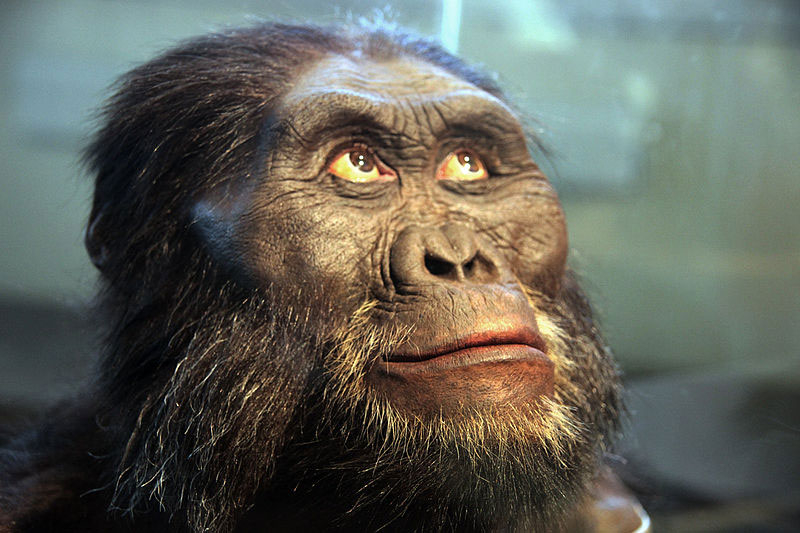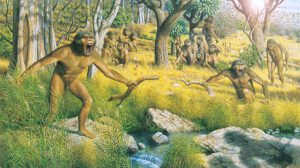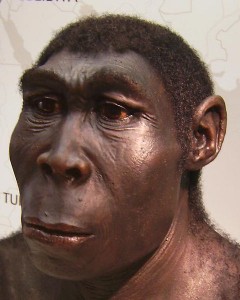Climate Effects on Human Evolution
This article explores the hypothesis that key human adaptations evolved in response to environmental instability. This idea was developed during research conducted by the Smithsonian’s Human Origins Program. Paleoanthropologists – scientists who study human evolution – have developed a variety of ideas concerning how environmental conditions may have stimulated long-term human evolutionary change.
Natural selection was not always a matter of ‘survival of the fittest’ but also survival of those most adaptable to changing surroundings.
By the Smithonian
Background
Paleoanthropologists – scientists who study human evolution – have developed a variety of ideas concerning how environmental conditions may have stimulated long-term human evolutionary change. Human evolution has involved the emergence of a diverse suite of species and an accumulation of adaptations, including bipedal walking, the capacity to make and depend on tools, brain enlargement, changes in growth, and the emergence of complex mental and social behavior.
An important feature of Earth history during the period of human evolution is environmental change, including cooling, drying, and wider climate fluctuations over time. The question arises, then, how environmental change may have shaped the evolution of new adaptations and the origin or extinction of early hominin species and the emergence of our species, Homo sapiens. (The word ‘hominin’ here is used to refer to branches (= lineages or species) of the human evolutionary tree since the divergence of human ancestors and chimpanzee ancestors from a common ancestor, estimated to have lived between 6 and 8 million years ago.)
Environmental Fluctuations
How do we know that earth’s climate has changed? How do we know how quickly and how much climate has changed? One of the ways we can look at environmental change is through the record of oxygen isotopes through time.

Foraminifera in Ngapali, Myanmar.
This record of δ18O, or oxygen stable isotopes, comes from measuring oxygen in the microscopic skeletons of foraminifera (forams, for short) that lived on the sea floor. This measure can be used as an indicator of changing temperature and glacial ice over time. There are two main trends: one toward an overall decrease in temperature, the other toward a larger degree of climate fluctuation. The amount of variability in environmental conditions became greater in later stages of human evolution than in the earlier stages.
There are two isotopes of oxygen, 18O and 16O. Isotopes are forms of the same chemical element that have different atomic weights resulting from different numbers of neutrons in the nucleus. During evaporation, more 16O evaporates than 18O. Microorganisms in the ocean, such as foraminifera, are more likely to incorporate 18O than 16O in their skeletons. The ratio of the two isotopes in the skeletons of marine organisms changes as temperature changes. When the temperature drops, even more 18O is found in the forams. During glacial periods, more 16O ends up in locked away in ice. To get information about the ratio of oxygen isotopes, ships drill deep into the ocean floor to get a deep sea core that contains the remains of the forams, which can be tested to determine their isotopic composition.
Organisms and Environmental Change
All organisms encounter some amount of environmental change. Some changes occur over a short time, or might be cyclical, such as daily or seasonal variations in the amount of temperature, light and precipitation. On longer time scales, hominins experienced large-scale and unpredictable shifts in temperature and precipitation that in turn caused vast changes in vegetation – from grasslands to forests, and from extremely cold to warm climates. Hominin environments were also altered by tectonics, such as the uplift of the Tibetan Plateau, which changed rainfall patterns in northern China and altered the topography of a wide region. Tectonic activity can change the location and size of lakes and rivers. Volcanic eruptions and forest fires also altered the availability of food, water, shelter, and other resources. Unlike seasonal or daily shifts, the effects of many of these changes lasted for many years, and were unpredictable to hominins and other organisms as to when the next major shift would take place.
Many organisms have habitat preferences, such as particular types of vegetation (grassland versus forests), or preferred temperature and precipitation ranges. When there’s a change in an animal’s preferred habitat, animals can either follow their favored habitat, become extinct, or adapt to the new habitat. The ability to adjust to a variety of different habitats and environments is a characteristic of humans.
Adaptations to Change
There are many ideas about the role of the environment in human evolution. Some views assume that certain adaptations, such as upright walking, or tool-making, were associated with specific habitats. These types of hypotheses are referred to as habitat-specific. The best known habitat-specific hypothesis is the savanna hypothesis, which states that many important human adaptations arose on the African savanna or were influenced by the environmental pressure of an expanding dry savanna. According to this idea, upright walking proved to be a beneficial way of moving across an open landscape. Another version of this idea is that upright walking had the additional advantage of freeing the hands, which was advantageous for carrying items and making tools in the African savanna. Other habitat-specific hypotheses consider woodlands or forests or cold habitats as the key to certain adaptations.
If key human adaptations evolved in response to selection pressure by a specific environment, we would expect those adaptations to be especially suited to that habitat. Hominin fossils would be found in those environments and not present in different types of habitat.
The Variability Selection Hypothesis
A different hypothesis to explain events in human evolution has been developed by Dr. Rick Potts of the Human Origins Program. In his variability selection hypothesis, certain adaptations of early human ancestors were not shaped by any single type of habitat or environmental trend; instead, environmental instability was a key to the evolution of important human adaptations. Hominins were not limited to a single type of environment, but were found in a many different environments. Over the course of human evolution, hominins increased their abilities to cope with a number of different environments rather than specializing on a single environment. How did hominins get the ability to respond to new environmental conditions and to dramatically shifting surroundings?
One way organisms can cope with environmental fluctuations is through genetic adaptations, such as polymorphism. Several alleles, or different versions of genes, are present in the population at different frequencies. As conditions change, natural selection favors one allele or genetic variant over another. Genes that can facilitate a range of different forms under different environments (phenotypic plasticity) can also help an organism adapt to changing conditions.
Another response to environmental change is to evolve structures and behaviors that can be used to cope with different environments. The selection of these structures and behaviors as a result of environmental instability is known as variability selection. This hypothesis differs from those based on consistent environmental trends. Environmental change in a constant direction leads to specializations for those specific conditions. But if the environment becomes highly variable, specializations for particular environmental conditions would be less advantageous than structures and behaviors helpful for coping with changing and unpredictable conditions. Variability selection favors adaptations that help organisms survive unexpected changes. To test the variability selection hypothesis, and to compare it with habitat-specific hypotheses, Potts examined the hominin fossil record and the records of environmental change during the time of human evolution.
If environmental instability was the key factor producing human adaptations, increasing amounts of environmental fluctuation would be expected over time, and the new adaptations would have improved the ability of early human ancestors to inhabit a variety of environments and enabled their populations to survive unpredictable habitat change and environmental events. Overall, the hominin fossil record and the environmental record show that hominins evolved during an environmentally variable time. Higher variability occurred as large-scale changes in seasonality produced major environmental fluctuations at orbital time scales of tens of thousands of years.
The variability selection hypothesis implies that human traits evolved over time because they enabled human ancestors to adjust to environmental uncertainty and change. The hypothesis addresses the matter of how, exactly, adaptability can evolve over time.

Ancient Hominins Were Found in Diverse Habitats
Ancient hominin remains have been found in a variety of different habitats. While some hominins, such as Orrorin tugenensis and Ardipithecus kadabba have been found in wooded habitats, others such as Sahelanthropus tchadensis were found associated with more diverse types of vegetation within a small geographic area. Reconstructions of the ancient habitat of Ardipithecus ramidus at two different Ethiopian sites suggest that this species occupied both wooded areas (the Aramis site) and wooded grasslands in which grazing animals predominated (the Gona site). Australopithecus anamensis has been found at Kanapoi and Allia Bay, Kenya, in association with another type of mosaic – an open savanna with low trees and shrubs, but with both grasslands and gallery forests nearby.
At Kanapoi, research by Dr. Jonathan Wynn on paleosols and pedogenic carbonates demonstrates the presence of these varied habitats at the time when Australopithecus anamensis inhabited the area. Other members of A. anamensis at Allia Bay encountered a different environment. The fossil animals represent several different habitats including open floodplains, gallery forests, and dry bushlands. Isotopic studies done by Dr. Margaret Schoeninger and her colleagues indicate that most of the Allia Bay vegetation consisted of woody plants such as trees and shrubs (known as C3 vegetation). Australopithecus anamensis at Allia Bay was thus associated with a mosaic environment, including woodlands near the ancestral Omo River and open savanna further away.
Two Legs, Long Arms; Moving Around in Diverse Habitats
By about 4 million years ago, the genus Australopithecus had evolved a skeletal form that enabled adjustments to changes in moisture and vegetation. The best current example of adaptability in Australopithecus is apparent in the skeleton known as Lucy, which represents A. afarensis. Lucy’s 3.18-million-year-old skeleton has a humanlike hip bone and knee joints coupled with long apelike arms, longer grasping fingers than in humans, and flexible feet for walking or climbing.
This combination of features, which appears to have characterized Australopithecus for nearly 2 million years and possibly older hominins, afforded an ability to move around in diverse habitats by changing the degree of reliance on terrestrial walking and arboreal climbing. This flexibility may also have characterized earlier hominins such as Ardipithecus ramidus.


Australopithecus
Stone Toolmaking: Gaining Access to Diverse Foods
Making and using stone tools may also be considered to have evolved due to the versatility it afforded, in this case dietary versatility. Stone tools conferred significant advantages. The first known stone tools date to around 2.6 million years ago.
Simple toolmaking by stone-on-stone fracturing of rock conferred a selective advantage in that these hominin toolmakers possessed sharp flakes for cutting and hammerstone that were useful in pounding and crushing foods. Basic stone tools thus greatly enhanced the functions of teeth in a way that allowed access to an enormous variety of foods. These foods included meat from large animals, which was sliced from carcasses using sharp edges of flakes.
Bones were broken open using stones to access the marrow inside. Other tools could be used to grind plants or to sharpen sticks to dig for tubers. Tool use would have made it easier for hominins to obtain food from a variety of different sources. Tool use would have widened the diet of hominins. Meat, in particular, is a food that obtainable in equivalent ways in virtually any type of habitat that early humans may have encountered.
Although making simple toolmaking may have elicited originally in one type of environment, the carrying of stone tools over considerable distances – and becoming reliant on stone technology – may have arisen due to the benefits of altering the diet as environments changed. The oldest known stone technology – called Oldowan toolmaking – involved carrying rock over several kilometers and is found associated with a variety of ancient habitats. Redistributing stone and other resources, such as parts of animal carcasses, by transporting them may have helped hominins cope with variable habitats.
The Expanding World of Early Homo
As predicted by the variability selection hypothesis, hominins were not found solely in one kind of habitat, but rather in a variety. A major signal of the ability to tolerate different environments was the dispersal of hominins beyond Africa and into Asian environments. After 1.8 Ma, hominins are found in a variety of locations in Asia, including some that are relatively far north. Compare the ranges of Australopithecus afarensis and Homo erectus.
Early evidence of the diversity of Homo erectus environments in Asia includes the following sites:
- Dmanisi, Republic of Georgia, 1.7 Million years ago. This site has grasslands surrounded by mountains with forests. Hominins had access to lava as a raw material for tools.
- Yuanmou, China, 1.7 Million years ago. This site, located near an ancient lake, had a mixture of habitats with grasslands, bushlands and forests.
- Nihewan Basin, China, 1.66 Million years ago. The Nihewan sites were also near a lake. They experienced many changes in vegetation over time, with habitats ranging from forests to grasslands. This region may have been much more arid than others, and temperatures changed seasonally between warm and cold.
- Java, 1.66 Ma: Hominins here encountered grasslands, rivers and marine coastal environments in a tropical latitude setting.
In these locations, hominin groups encountered distinctly different environments, different plants and animals and foods, and different climatic conditions – both an increased temperature range and wide variations in aridity and monsoonal rains.
Hominins Persist Through Environmental Change
Environmental instability may have been a factor not only in shaping adaptations but also in contributing to the extinction of some lineages. Environmental variability associated with a pattern of extinction has been proposed for the southern Kenya region. Sediments, stone artifacts, and animal faunal at the site of Olorgesailie span most of the past 1.2 million years. Numerous environmental shifts are recorded in the Olorgesailie deposits. The ancient lake level and its chemistry, for example, changed frequently, and sometimes the lake dried up, leaving small wetlands and streams as the main source of water in the basin. Volcanic eruptions also blanketed the landscape in ash, killing off grass and reshaping the properties of the ecosystem.
Around 700,000 to 640,000 years ago, the degree of global climate fluctuation increased. Dr. Rick Potts studied the pattern of climatic turnover in the fauna and the occurrence of archeological sites at Olorgesailie and another site in southern Kenya, and found that several large mammal species that had previously dominated the fauna of this region went extinct between about 800,000 and 400,000 years ago. These species were replaced by modern relatives, which tended to be smaller in body size and not as specialized in diet or habitat.

Phacochoerus Aethiopicus
For example, Equus oldowayensis had large and tall teeth specialized for eating grass. Its last known appearance in the fossil record of southern Kenya is between 780,000 and 600,000 years ago; it was replaced by Equus grevyi, which can graze as well as browse. The primate Theropithecus oswaldi, weighed over 58 kg (over 127.6 pounds), lived on the ground exclusively, had very large teeth and consumed grass. It went extinct between 780,000 and 601,000 years ago. Its extant relative, Papio anubis, is omnivorous and moves on the ground and in trees. Two other animals that were large in body size and specialized to eat grass, Elephas recki and Metridiochoerus, were also replaced by related species that were smaller and had more versatile diets (Loxodonta africana and Phacochoerus aethiopicus). The aquatic specialist Hippopotamus gorgops was replaced by another hippopotamus capable of traversing long distances between water bodies.
The replacement of the specialized species by closely related animals that possessed more flexible adaptations at a time of wide climate fluctuation was a key piece of initial evidence that led to the variability selection hypothesis. Although Acheulean toolmaking hominins were able to cope with changing habitats throughout much of the Olorgesailie record, the Acheulean way of life disappeared from the region sometime between 500,000 and 400,000 years ago, perhaps also a casualty of strong environmental uncertainty and changing circumstances.
Encephalization and Adaptability
Brain enlargement during human evolution has been dramatic. During the first four million years of human evolution, brain size increased very slowly. Encephalization, or the evolutionary enlargement of the brain relative to body size, was especially pronounced over the past 800,000 years, coinciding with the period of strongest climate fluctuation worldwide. Larger brains allowed hominins to process and store information, to plan ahead and to solve abstract problems. A large brain able to produce versatile solutions to new and diverse survival challenges was, according to the variability selection hypothesis, favored with an increase in the range of environments hominins confronted over time and space.
New Tools for Many Different Purposes
After 400,000 years ago, hominins found new ways of coping with the environment by creating a variety of different tools. In some parts of Africa, a shift occurred in which a technology dominated by large cutting tools was replaced by smaller, more diverse toolkits. Technological innovations began to appear in the Middle Stone Age in Africa, with some early examples dating prior to 280,000 years ago. Some of the new tools provided ways for hominins to access food in new ways. Points were hafted, or attached to handles such as spear or arrow shafts, and were later used as part of projectile weapons, which allowed hominins to hunt fast and dangerous prey without approaching as closely. Barbed points were used to spear fish. Barbed points made from bone were found at the site of Katanda, in the Democratic Republic of the Congo, along with the remains of huge catfish. Grindstones were used to process plant foods. They date to before 280,000 years ago. Other tools were used to make clothing which would have been important for hominins in cold environments.
Regional Exchange and Social Networks
Trading between groups to obtain materials and to cement alliances is a hallmark of modern human behavior. Larger brains and symbolic ability facilitated more complex social interactions. By 130,000 years ago, hominins were exchanging materials over distances of over 300 km. The social bonds that were forged by exchanging materials between groups may have been critical for survival during times of environmental change when one group relied on the resources or territories of a distant group. Modern foragers use social ties to mitigate the effects of famines and droughts. The exchange of gifts maintains relationships between groups, which may be called upon when one group needs to live at another’s camp or waterhole.
Communication and Symbols
Evidence of the human capacity for communication with symbols is apparent in the archeological record back to at least 250,000 years old. The use of color, incised symbols, decorative objects, and language are part of this capacity for communication. Symbolic communication may be linked with information storage. Language is an essential part of communication. Language makes it possible to convey complex ideas to others. Communication of ideas and circumstances via language would have made survival in a changing world much easier. However, there is no fossil evidence for language.
Preserved pieces of pigment are one of the earliest forms of symbolic communication. Ocher and manganese can be used to color objects and skin. Other symbolic objects such as jewelry, personal adornments, and art convey information about the owner’s social status, group membership, age or sex. Paintings and drawings were also used to represent the natural world. Use of symbols is ultimately connected to the human ability to plan, communicate and record information.
Neanderthals Endured Climatic Oscillations, Too!
Neanderthal populations (Homo neanderthalensis) in Europe endured many environmental changes, including large shifts in climate between glacial and interglacial conditions, while living in a habitat that was colder overall than settings where most other hominin species lived. Some of the environmental shifts they endured involved rapid swings between cold and warm climate.
The Neanderthals were able to adjust their behavior to fit the circumstances. During cold, glacial periods, they focused on hunting reindeer, which are cold-adapted animals. During warmer, interglacial periods, they hunted red deer. During extreme cold periods, they shifted their range southwards into warmer conditions.
Neanderthals and modern humans had different ways of dealing with environmental fluctuation and the survival challenges it posed. Modern humans, Homo sapiens, had specialized tools to extract a variety of dietary resources. They also had broad social networks as shown by the exchange of goods over a long distance. They used symbols as a means of communicating and storing information. Neanderthals did not make tools that were as specialized as those of modern humans, and usually did not exchange materials over so wide a distance. They occasionally produced symbolic artifacts. Despite many climatic fluctuations, modern humans were able to expand their range over Europe and Asia, and into new areas such as Australia and the Americas. Neanderthals went extinct.
Conclusion
Overall, the evidence shows that hominins were able to adapt to changing environments. The genus Homo, to which our species belongs, also had the capacity to adjust to a variety of environmental conditions all over the world. Homo sapiens is especially able to cope with a broad range of climatic conditions, hot and cold environments, arid and moist ones, and with all kinds of varying vegetation. We use resources from a vast variety of plants and animals and use many specialized tools. We have many social contacts and means of exchanging resources and information to help us survive in a constantly changing world.
Humans today represent the one species that has survived of what has been a diverse evolutionary tree, composed of species that had a variety of adaptations and ways of life. Despite their very close relationship with our species, and despite the fact that all of them possessed some combination of features that characterize humans today, these earlier species and their ways of life are now extinct. The question ahead is how well our sources of resilience as a species will succeed as our alterations to the landscape, atmosphere, and water sources interact with the tendency of Earth’s environment to shift all on its own. This is an ‘experiment’ just now unfolding, one that has never been tried before.
The intensity of environmental change seems likely to create entirely new survival challenges for the lone hominin species on the planet, and many other organisms as well.
Related Effects of climate change on humans
Teaser image via Wikipedia.
About the Author: CLIMATE STATE
POPULAR
COMMENTS
- Robert Schreib on Electricity generation prices may increase by as much as 50% if only based on coal and gas
- Robert Schreib on China made a historic commitment to reduce its emissions of greenhouse gases
- Lee Nikki on COP30: Climate Summit 2025 – Intro Climate Action Event
- Hollie Bailey on Leaders doubled down on fossil fuels after promising to reduce climate pollution
- Malcolm R Forster on Mythbusters tests global warming theory – does CO2 warm air?

